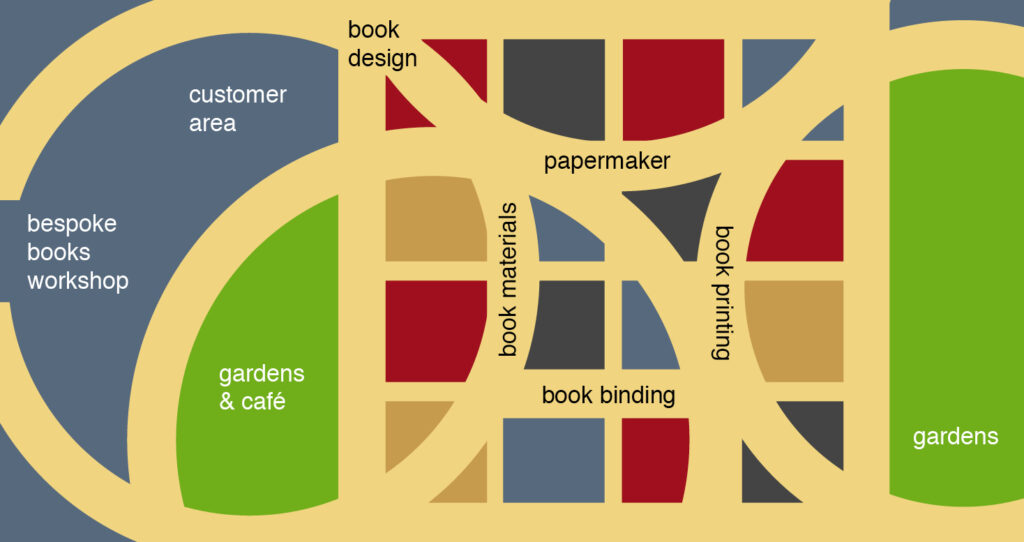bespoke books network
The workshops

It is probably best to set up bespoke books workshops for the network to ensure sustainable working practises from the start.
The network will need a minimum size so that enough orders come in for each workshop.
A bespoke books workshop has three main sources for orders:
- Direct orders from local customers
- Orders from local bookshops
- Orders via the network website
Depending on the wishes of the craftspeople in the workshop, and also depending on the region, a workshop could be extended to include book repairs, general printing and a customer area. Or a bespoke books workshop can be integrated into a book station.

Tasks at a bespoke books workshop
- Work with the customer on the layout, design elements & materials
- Make paper and cover materials
- Create the book cover
- Add illustrations
- Set the book
- Print all parts
- Bind all parts
- Add a unique code to the book (e.g. embossed on the leather cover)
- Issue a certificate of authenticity
A bespoke books workshop could work with independent illustrators or decide to get together a permanent team of craftspeople and artists who specialise in bespoke books.

Case 1
The head of the Bangkok bespoke books workshop receives a request for a bespoke edition of the verse drama Ramakian. The customer is an illustrator herself and would like to work closely with the workshop’s illustrators.
At the first meeting with the customer, papers and cover materials are inspected, layout options and the size of the book are discussed, and a schedule for the next steps is completed.
Over the next two weeks the customer and the workshop’s illustrators work together closely.
When the drafts for all illustrations are completed, the proposed layout is revised and some changes are made.
Next a draft copy of the book is produced, and after some final adjustments the bespoke book is created.
This is a single and unique edition which will be registered and documented at the workshop but which cannot be reproduced.
When the customer picks up her bespoke book, she also receives a certificate of authenticity.

Case 2
The network’s team for western Europe has been crunching numbers and decides that the increasing popularity of bespoke books should bring in enough work for twelve additional workshops. Being careful, they decide to set up two new workshops every other month, and only continue with extending the network as long as the numbers hold.
The first new workshop will be in Bergen, Norway. The special point about this workshop is that it also offers ocean-compatible prints, meaning that the books can survive a high concentration of salt in the air, and are much less affected by some drops of seawater than standard paper. You still can’t go swimming with such a book, but overall it’s a lot more resilient than your average on-land book.
Orders for these books are already piling up, but the network can’t move as fast as it likes.
The workshop is built quickly enough, a number of timber buildings and a stone building for the laboratory, all embedded in a natural garden on the outskirts of Bergen. But finding all the craftspeople and artists needed for this workshop, is more difficult.
In the end, the six initial members of the workshop agree to train six newcomers to complete their team. And here they get lucky: two students sign up, two pensioners and funny enough two former sailors.
The good thing about the training period is that the scientists on the team can further develop and test their ideas for resilient books and involve all members in the process.
After about six month, the team is ready to start. There are still some wobblers, but after another six months their production runs smoothly.
By then all twelve new workshops have been set up in western Europe and are running fine. And by the looks of it, for now the network has all the bespoke books workshops it needs. And it has enough revenue to support the local communities.

Case 3
The curiosity bespoke books workshop in Prague, Czech Republic, is coming into global fame for its extraordinary book editions.
In fact, the bespoke books network set up another workshop in Prague which handles the more established bespoke books orders so that the curiosity workshop can keep up with the demand for extraordinary prints.
Plus, the curiosity craftspeople train craftspeople from around the world so that those can set up their own curiosity workshops.
It all started with classics and world records, such as the smallest and the largest book edition of Kafka’s The Trial.
And then young Nikola visited the bespoke books workshop with a special request: she wanted a book with short stories by Czech authors printed on different kinds of paper, each paper representing a different author and a different natural resource such as wood, sugarcane, bamboo, straw, cork, reed, cotton, fruit peels, nutshells and so on. The covers were to be made of two woodcarvings, Nikola would carve herself.
In the following weeks, the paper makers at the workshop had a great time and used this contract to experiment and develop more kinds of paper than any other bespoke books workshop to that date. And at the same time the book people got drunk on ideas for bespoke books no one had ever dreamed up.
Over the following months, the craftspeople transformed their workshop into a place where nothing is impossible.
You want an edible book? No problem. Single flavour or multi flavour? Sweet or spicy?
You want a book made of actual leaves? No problem. Single leaf? Or a whole mixed forest worth of leaves?
You want a book you can close with buttons? No problem. Single buttons? Or a collection of buttons, and should the title be made of buttons too?
You want a book made of metal sheets? No problem. Printed? Or engraved?
Of course, there were people who brought up ideas which were simply a waste of resources. Like a love story printed on condoms. To which Hynek, head of the workshop, said: ‘Dear, I don’t mind printing your love story on silk and add a pouch for condoms, but we are not wasting materials.’
Admittedly the question of what is a waste of material, and what isn’t, is a bit critical.
